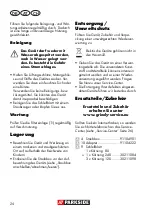
9
NI
IE
GB
Special safety instructions
for oscillating sanders
Warning! Sanding can result
in the formation of hazardous
dusts (e.g. arising from mate-
rials such as paints containing
lead, materials containing as-
bestos, metals or some wood
types), which can present a
health hazard to the opera-
tor or persons in the vicinity
if touched or inhaled. Make
sure that the workplace is well
ventilated. Always wear safe-
ty goggles, safety gloves and
respiratory protection. Attach
a dust extraction system.
a)
Secure the workpiece.
A work-
piece that is retained with clamping
appliances or a vice is held more se-
curely than with your hand.
b)
Only use the power tool for dry
sanding. Do not scrape moist
materials.
Penetration of water into
the power tool increases the risk of
electric shock.
c)
Avoid overheating the sanded
object and the sander itself.
Pos-
sible fire hazard.
d)
The workpiece gets hot dur-
ing grinding. Do not touch the
machined area, allow it to cool
down.
There is a risk of burning. Do
not use coolants or the like.
e)
Always empty the dust container
before work breaks.
Sanding dust
in the dust sack, micro filter, paper sack
(or in the filter sack or extraction system
filter) can self-ignite under unfavourable
conditions such as flying sparks caused
by grinding metals. Particular hazards
are caused if the sanding dust is mixed
with paint, polyurethane residues or oth-
er chemical substances, or if the sanded
object is hot after long working periods.
Please check the operating manual of
your vacuum cleaner whether it is suit-
able for the suction of grinding chips.
f)
Connect the appliance to a power
socket with a residual current circuit
breaker of rated residual current no
more than 30 mA.
g) If the supply cord of this power
tool is damaged, it must be re-
placed by a specially prepared
cord available through the ser-
vice organization.
h)
Avoid working with materials that may
be harmful to health, e.g. asbestos or
lead paints.
i) Always hold the device tightly
with both hands.
j) Wait for the sanding sheet to
come to a stop before putting
the device down.
k) Remove the mains plug:
- before working on the appliance;
- when taking a break;
- before changing the setting on the device;
- before servicing and repair;
- before maintenance and repair work.
l) Keep the device clean and dry.
Residual risks
Even if properly operating and handling this
electric tool, some residual risks will remain.
Due to its construction and build, this elec-
tric tool may present the following hazards:
a) Lung damage, if suitable respiratory
protection is not worn;
b) Abrasions.
c) Ear damage if working without ear pro-
tection.
d) Eye damage if suitable eye protection is
not worn.










































